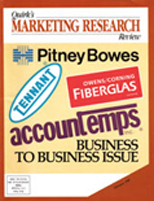High interest rates in the early 1980s were preventing many people from buying new homes. Adding on to, improving and remodeling the home became the only feasible alternative.
According to industry experts in the home improvement market, money spent by American consumers on repair and remodeling was predicted to exceed dollars spent on housing. This phenomenon occurred in 1982. In that year, estimated the Greenbook Of Home Improvement Contractors, $1.15 was spent on remodeling for every dollar spent on new housing. As a result, Owens-Corning Fiberglas, one of the world's leading manufacturers of glass fiber materials, decided to initiate a study of insulation usage among various segments comprising the home improvement contractor market.
The objective of this study was qualitative in nature (as opposed to quantifying the size of the market) to determine how and where insulation products were being used among home improvement contractors. Furthermore, Owens-Corning wanted to determine the degree to which their current marketing programs (including all variables: price, promotion, product and distribution) were fulfilling the needs of this growing segment.
Research objectives
In addition to the overall objective, other key objectives were to be met from the research. These were to: determine the incidence and application of various insulation types among home improvement contractors; determine the incidence and application of foam board sheathing; determine brands of insulation/sheathing used and level of satisfaction with brand; evaluate brand buying decision, i.e., who makes the brand decision, where the product is purchased and the importance of various brand attributes; determine how contractors market their service as well as other basic business demographics.
Research methodology
A questionnaire was mailed to 450 contractors selected from the 1983 edition of the Greenbook of Home Improvement Contractors in October, 1984. Insulation contractors who were identified as so in the Greenbook were eliminated from the sampling. Since the number of home improvement contractors is a finite group, the Greenbook proved valuable in locating these small businesses.
"Many of these contractors are hard to find because they're small 'ma and pa' shops and on the road a lot," says Mark Packer, formerly senior market research analyst at Owens-Corning.
Questionnaires were mailed to the sample along with a cover letter explaining the survey. Those who did not respond to the initial mailing were sent a reminder post card. Those who did not respond received a second reminder with another copy of the questionnaire. Telephone calls were then made to non-responses to boost return rates. As an added incentive, a drawing was held at the end of the data collection with the winner receiving a free trip for two to Las Vegas. This extra effort to boost returns reduced significantly non?response error and negated the need to greatly oversample.
High returns
This technique resulted in 417 returns for a return rate of 93%. One reason Packer believes the response rate was so high was because of some "hard-nosed," diligent work by the nationally-known research supplier which was responsible for designing the project and conducting the field work for Owens-Corning. Owens-Corning was obviously very pleased with the number of returns, considering it previously had unsuccessful results conducting a telephone survey by another supplier who told them the project was impossible to do.
Marketing program
The results of the project are being used for a marketing program at Owens-Corning which is directed toward home-improvement remodelers, says Edward Zinn, manager marketing research, construction products group.
"The project is helping us understand the buying process better and to provide tools which will get the remodelers to use our products more," says Zinn.
Added Packer, "The results raised our awareness of this segment of the market to their needs and product requirements. They are a valuable segment of the market Owens-Corning needs to address.
